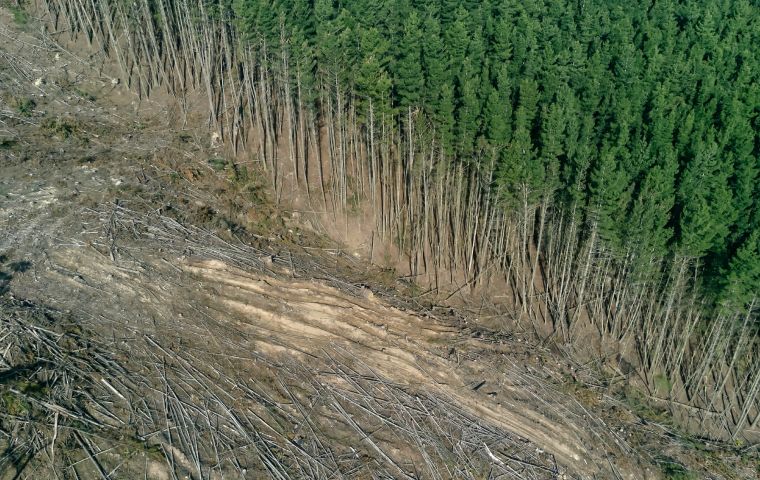MercoPress. South Atlantic News Agency
One third of Latin America, Caribbean forests under threat, study finds
 In the last 300 years forest areas have shrunk by 40% worldwide.
In the last 300 years forest areas have shrunk by 40% worldwide. According to the Botanic Gardens Conservation International, “World Forestry Report” published Wednesday, one-third of the forest wealth in Latin America and the Caribbean is under threat of extinction.
Of the nearly 60,000 species of trees catalogued globally, around 30% are threatened with extinction, the document noted. The study also showed a similar percentage applied to the rest of the planet.
Latin America and the Caribbean is the region with the greatest forest richness by far: almost 24,000 classified tree species (40% of the world's total), of which 7,000 are under threat (31%).
Only 31 species are considered definitively “extinct” (0.1%), according to this world classification, a work which took scientists both of state-run and non-governmental organizations five years to complete.
The region of the planet most affected by the risk of extinction is Africa. Of the just over 9,000 classified tree species, almost 40% are under threat. Agriculture, logging and ranching together account for 70% of threats, while climate changes only 4%.
In the last 300 years, forest areas have shrunk by 40% worldwide. Twenty-nine countries lost more than 90% of their trees. That amount would match figures from the Industrial Revolution, which represented an economic and demographic growth unparalleled in history.
Seven commodity crops are responsible for more than half of deforestation worldwide, the Botanic Gardens Conservation International survey showed. But there are also other reasons, such as the one affecting the Honduran rosewood (Dalbergia stevensonii), which is a Central American tree whose wood is incredibly dense, highly valued for making musical instruments.
Due to the demand, the forests of this prized species in Belize have practically disappeared, and the tree is on the Red List of “critically endangered” species.
“Tree species that have evolved over millions of years, adapting to climatic changes, cannot now survive the devastation caused by human threats,” explained Jean-Christophe Vié, CEO of the Franklinia Foundation.
In Amazonia and according to another study also published Wednesday in the journal Nature, between 103,079 and 189,755 km2 of rainforest have suffered fires since 2001. The Amazon rainforest, which extends over the territory of nine countries, has a total area of about 5.5 million km2, a 20% decrease compared to the 1960s. For every 10,000 km2 of forest burned, some 30 species of plants and 2.5 species of animals suffered a significant loss of habitat.




Top Comments
Disclaimer & comment rules-

-

-

Read all commentsHey Gibbering F*uckwitt, answer if you’re not too scared.
Sep 03rd, 2021 - 06:56 pm 0What's that sucking sound. Oh I see the clinker still has his nose to the grindstone.
Sep 04th, 2021 - 10:31 am 0P U G O L — TTWH
Sep 04th, 2021 - 01:18 pm 0Chile because of its favorable tax laws has planted tens of thousands of new forests in our country and have dramatically increased the size of nature reserves to protect natural reasources.
We enjoyed delicious pain au chocolat with perfectly prepared caffè late with the morning sun illuminating the Pacific. It’s really a beautiful day!
Today’s luncheon with naval companions in Valparaiso should be highly entertaining.
¡Saludos cordiales desde Viña del Mar!
Commenting for this story is now closed.
If you have a Facebook account, become a fan and comment on our Facebook Page!